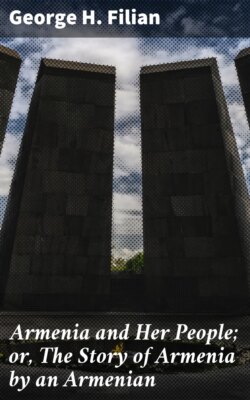Читать книгу Armenia and Her People; or, The Story of Armenia by an Armenian - George H. Filian - Страница 11
На сайте Литреса книга снята с продажи.
PHYSICAL FEATURES.
ОглавлениеTable of Contents
Where is Armenia? It seems a simple question, yet during my lecturing in the United States I have met far more people who did not know than who did. That is natural enough, for until the late horrors, it seemed little more than a name of old history, of no present importance; but there is a further reason. The present Sultan forbids the use of the name altogether, and insists on the district being termed Kurdistan, or called by the names of its vilayets, Diarbekr, Van, Erzroom, etc. Many maps do not have the name Armenia at all. A few years ago, when the missionaries of the American Board were organizing the college at Harpoot, now so bloodily famous, they named it Armenia College; but the Sultan forbade it on the ground that there was no longer an Armenia, and the use of the name would encourage the Armenians1 to revolt. The missionaries were forced to change the name to Euphrates College. If any Turkish subject uses the word, he is fined and imprisoned; if it is used in any book, the book is confiscated, and the author banished or killed. The study of Armenian history is forbidden to the Armenians; they must be kept in ignorance about their own land, so that many of them do not know where Armenia was or what Armenia is. A letter directed to any person or place in Armenia will never reach its destination; for the Turkish postal authorities recognize no such address. There is still another cause for the widespread ignorance concerning Armenia. It has been partitioned between three different powers, Turkey, Russia, and Persia. The northern part, from Batoum on the Black Sea to Baku on the Caspian—the river Araxes being the boundary to near Mt. Ararat—belongs to Russia; the southeastern course of the Araxes from near Mt. Ararat, to Persia; the largest and most fertile part, the western, from Mt. Ararat to the Black Sea and the Kizil-Irmak to Turkey. But at the time of its greatest extent and power, when its people were great and its kings were great, long before Alexander’s conquest—Armenia covered about 500,000 square miles, and stretched from the Black Sea and the Caucasus on the north to Persia, and Syria on the south, from the Caspian and a much smaller Persia on the east, to Cilicia and far beyond the Halys (Kizil-Irmak) on the west, but including also old Media and a part of Mesopotamia.
It is one of the most picturesque of countries; travelers call it the Switzerland of Asia. Its general character is that of a plateau some 4,000 feet above the sea, a natural garden watered by noble streams and studded with beautiful lakes; but the mountain ranges are 7,000 to 8,000 on the average, while that historic land-mark, the superb snow-capped Mt. Ararat, is about 18,000—towering toward Heaven nearly in the center of Armenia, piercing and ruling over the clouds and the storms.
MOUNT ARARAT.
Armenia is the mother land, the cradle of humanity, and all other lands are her daughters; but she is fairer than any other. Even her mountain tops of perpetual snow are a crown of glory; the sun kisses her brow with the smile of morning; and she supplies the beautiful rivers, Euphrates, Tigris, Pison, Araxes, and many others from the jewels of her crown. These rivers penetrate to every corner of the land; traverse many hundreds of miles to give life to the fields, the vineyards, and the orchards, to turn the mills, and finally close their course in the Caspian Sea, the Black Sea, and the Gulf of Persia, carrying the bounty and good-will messages of the mother land to her children in remote parts, to Persia, India, and Russia. From the same inexhaustible reservoir she feeds her noble lakes; Sevan (Gokche), Urumiah, Van and the rest. Lake Sevan is the only sweet-water lake; the others are salt. The most important is Lake Van, probably the most elevated of any large-sized lake in the world; it is 5,400 feet above sea level, and its area is 1,400 square miles. A few words from the author’s respected teacher, Professor Philip Schaff, will not be amiss. Schaff’s Bible Dictionary, page 68, “Physical Features of Armenia,” says: “It is chiefly an elevated plateau about 7,000 feet above the level of the sea, the highest peak being Mt. Ararat. The lower portions of the plateau are broken by valleys and glens, including the fertile valleys of the Euphrates and Tigris. It is watered by four large streams, the Araxes, the Kur, the Euphrates, and the Tigris; also by numerous lakes, one of the largest, the salt Lake Van, being over 5,400 feet above the sea.”
